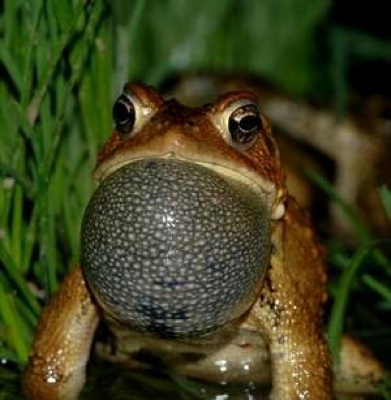
Native Delaware: Frog calls
Seasonal symphony of frog calls returns to Delaware
2:26 p.m., April 19, 2013--On April nights, Holly Niederriter can be found driving slowly down the back roads of New Castle County. Although she appears to be meandering, her excursions are quite purposeful. A wildlife biologist with the Delaware Department of Natural Resources and Environmental Control, Niederriter is listening for frog calls.
She is one of dozens of state residents who drive around after dark searching for frogs as part of the Delaware Amphibian Monitoring Program. The first survey period kicked off in late February, the second starts in a few days and the final survey occurs in June.
Campus Stories
From graduates, faculty
Doctoral hooding
Participants are volunteers from the community; most don’t have Niederriter’s wildlife savvy. But they all receive training, and before their debut, take an online quiz to ensure they can distinguish the calls of Delaware’s 16 species of frogs.
“Frog calls are an important way to determine where different species occur and how populations are doing over time,” says Niederriter. “Because most amphibians need both aquatic and upland habitats, they can serve as important indicators of water quality and other aspects of environmental health.”
A colder-than-average early spring made for a slow start to the frog-calling season. Early April is often the peak of spring peeper season, when the sleigh-bell-like chorus of these tiny frogs reaches maximum volume in vernal pools and marshes. But the beginning of this month was so chilly that the peepers didn’t want to peep.
“Male peepers call to attract a mate but if the weather isn’t warm enough they hunker down and wait it out,” says Jim White, associate director for land and biodiversity management at the Delaware Nature Society and an adjunct herpetology instructor at the University of Delaware. “I didn’t hear a single peeper during the first few days and nights of April.”
Now that temperatures are more seasonal, the spring peepers are out in full force. Recently, they’ve been joined by the pickerel frog, with its snore-like call, and the American toad, which boasts a musical trill. In the Coastal Plain region (Kent and Sussex, plus a sliver of New Castle County), you also can enjoy the throaty croak of the Southern leopard frog.
You need a sharp ear to recognize the call of the American toad, notes Jake Bowman, a UD professor of entomology and wildlife ecology. “American toads are frequently heard all over our area but rarely do people realize what they are hearing,” he says. “Unlike the commonly recognized sleigh bell call of the spring peeper, the American toad has a high pitched trill. Here on the UD campus, you can find them in most of the wetlands on our farm.”
A father of two sons, Lee, 10, and Ethan, 5, Bowman likes the fact that frogs are “kid-friendly.”
“Probably the nicest thing about toads is that it’s often the only amphibian kids have a chance to handle. My boys love the chance to chase and capture American toads and learn more about them,” he says. “After the boys have checked out the toads, we release them back where we found them.”
Like the Bowman boys, James White Jr. grew up playing with frogs with his father, Jim White. Now a UD freshman, White is majoring in wildlife conservation and hopes to become a national park ranger.
“For as long as I can remember, I went looking and listening for frogs every rainy, spring night,” says White. “We had a marsh only a few yards from our house so it was never difficult to hear them.”
“I will go herping with my father but because of college it probably won't be until school is out,” he says. “My favorite frog of spring is the pickerel frog. I always found them pretty frogs and very jumpy, making them a challenge to catch.”
If you want to catch frogs with your kids (or at least see and hear them), Bowman has a few suggestions. Look for terrestrial species on the ground in woodlands and other land habitats. Semi-aquatic species can be seen on the shoreline or surface of freshwater habitats. To find breeding frogs, head to vernal pools and marshes. Warm, rainy nights make for the very best frog-watching. Pack a bright flashlight and plenty of patience.
A spring peeper, for example, is only about an inch long and its brown, gray and green colors don’t stand out, especially at night. “You can practically be on top of them and still not see them,” notes Bowman.
But it’s worth the wait to see a peeper, especially a male one. Males have large vocal sacs under their chins that they pump full of air until they look like balloons about to burst, When they peep, the air is discharged and the shiny sac deflates.
How to Help
To learn more about volunteering with the Delaware Amphibian Monitoring Program, contact Vickie Henderson at 735-8651 or vickie.henderson@state.de.us.
Article by Margo McDonough
Photo courtesy of Jim White








